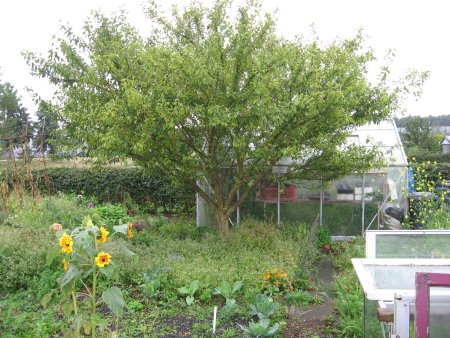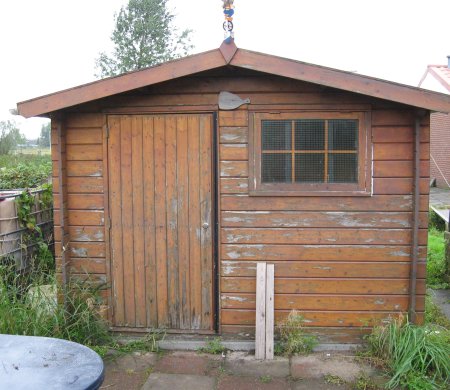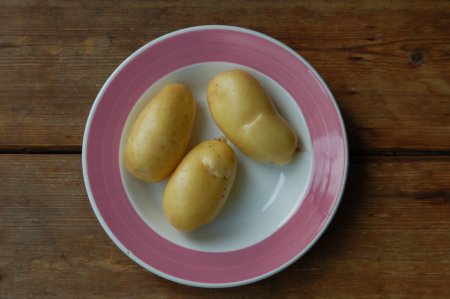The ink is still wet! I’ve just signed the paperwork for a community garden plot (an allotment in British English), just north of Amsterdam. It’s a 300m2 double-sized plot, and while one third the size of the old garden, it’s very large for something so close to Amsterdam.

This picture shows the greenhouse, plum tree and lots of weeds.
The person who owns the land I use as a garden now asked for it back some time ago, and I’ve been looking for a new place.
As these things usually are, my new garden is in need of a lot of work, and there is a lot of old rubbish to throw away. The previous owner didn’t do much work this last year, so it’s covered with weeds. There are also a number of existing plants, including 13 fruit trees, but not many old varieties, so I have a lot of work ahead pulling them out and replacing them over time. On the plus side, the previous owner left a greenhouse and shed for me, as well as a number of tools.

This is the shed the previous owner left behind.
This garden community consists of nearly 100 gardens, pretty much all of them are used primarily for growing vegetables. Nearby, under different management, are a couple of other community gardens some of which allow houses to be built on the plots and are primarily used for growing flowers.
In many ways the differences between the vegetable growing plots and flower growing plots are the same as the differences between similarly oriented gardening blogs! Holland also has a really weird culture surrounding their community gardens. It’s taken a while to find a community garden that had both space and like minded fellow gardeners.
In several places in northern Europe, including Holland, community gardens were historically used as a place for people to grow their own food. In many cases these were very important before and during WWII, but after the war as food became more easily available many of the gardens fell into disuse.
Because Holland is such a tiny country, as a way of preserving agricultural land and providing space for future urban growth, the cities are all built in a very compact way. In the major cities like Amsterdam or The Hague, home gardens are very rare, because there just isn’t space allocated for them. Only very wealthy people have any garden at all in cities, and almost all gardens are small. In more remote places there is more space, and gardens are more common.
Because gardens are so hard to come by in cities, in recent times people have been looking to community gardens as an alternative. This is why some of the local community gardens primarily have people who grow flowers and allow people to also have a small house on them. A ‘small house’ usually means something along the lines of pre-fab garden houses, that are sometimes sold in garden centers. Most of these houses are not suitable for winter use, and fall apart after about 10-15 years of use. In summer, many people live out of these houses. Some people literally use their garden plot to grow grass, and settle in for the summer with a barbecue and a radio. Many community gardens have running water, electricity and sometimes gas service. They usually have community toilets as an alternative to sewage services. Since canals and dikes are used here to keep the land dry, it’s usually possible to discharge ‘grey water’ from showers or sinks into a nearby canal.
Most of these community gardens that have houses aspire to be ‘high class’, and there is an ongoing effort to improve them. There is frequently a lot of pressure put on the gardeners to keep their gardens to very high standards. Many of them have the rule that you can’t grow only vegetables, because they aren’t considered attractive enough. There are frequently contests or other activities where gardens are rated or compared with one another. This all often means there is frequently a lot of lush growth, often making finding a spot with enough direct sunlight to grow vegetables a challenge.
All community gardens here require you to volunteer a number of hours in order to maintain the common areas. This is almost always on Saturday, because it’s a weekend day when everyone can attend during the day as many people object to working on Sunday. Many of these high class gardens have very high aspirations for their common areas, and expect you to attend as many as eight Saturdays per year for volunteer work, usually from about 10:00 to 14:00. As far as I’m concerned, this is the heart of the day not leaving a lot of time to do other things, and eight days a year means every other weekend in the summer months. I find this a lot of volunteer hours.
Many of these community gardens are so proud of their appearance, they are open to the public and encourage people to take walks through them as a sort of community service. To me this seems great if you want to show off your flowers, but not so good if you don’t want strangers taking your vegetables.
In all community gardens, when you take over a plot, you are always expected to pay the previous gardener something for the value of what is being left over for you. Officially the amount of money you have to pay is determined by an assessment made by the garden management, but in reality the previous owner has a lot of influence over the amount paid.
Many people consider these garden plots to be something of an investment, and expect to get more money from the next owner than they themselves paid. In addition, because many of these community garden plots are in short supply, new owners are often forced to pay whatever is being asked, because otherwise there are no alternatives available. This means there is often a cycle of ‘irrational exuberance’ in the turn over of these gardens, and the prices are often sky high! Many people plant a few more flowers, and justify this as sufficient improvement for an increase in value. Others really deck out the house, with a fresh coat of paint, solar panels, wooden deck or whatever.
For some of these gardens you are expected to pay as much as 15,000 euros, or nearly US$25,000! In any event, prices below 5000 euros for a reasonable garden are rare. Even after you pay this initial cost, you still have to pay rent on the land and management fees, usually about 1000 euros per year.
Especially if you are someone like me who wants to grow mostly vegetables, you are looking at first paying way too much money for someone else’s flowers, only to have to remove them and then when you sell your plot it’s not likely to have much value.
Some of these community gardens that are primarily for houses and flowers, also have a few ‘special’ plots on the side for people who want to grow vegetables. In this case, the price asked for these plots are often more reasonable. At the same time they are often tiny second class plots, primarily for students, because of course flowers are more important than vegetables and you don’t need as much space if you don’t have a house! In this case there is still the same expectation for volunteer hours.
For some reason a lot of these community gardens do not have good public transportation connections, and it’s often assumed that some people may come by bicycle, but most will drive their cars. One of the nice things about my new garden is it has pretty good public transportation access, and would be a bit of a long ride but possible to do on a bike.
For the greenhouse, shed and two cold frames, together with a large collection of tools, I paid the previous owner 500 euros for his garden. This community garden requires three volunteer Saturdays per year, and there are no rules about what my garden has to look like or what I grow. There is a strong commitment within the management to keep costs as low as possible, and the annual fees (including rent) are about 450 euros, which I find all very reasonable. It is fortunately not open to the wider public, and there is pretty good security in the form of fences and gates.
Let the weed digging begin!!


